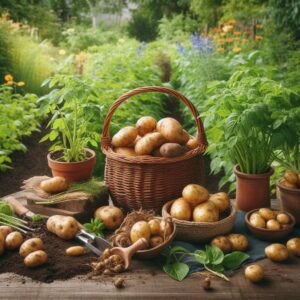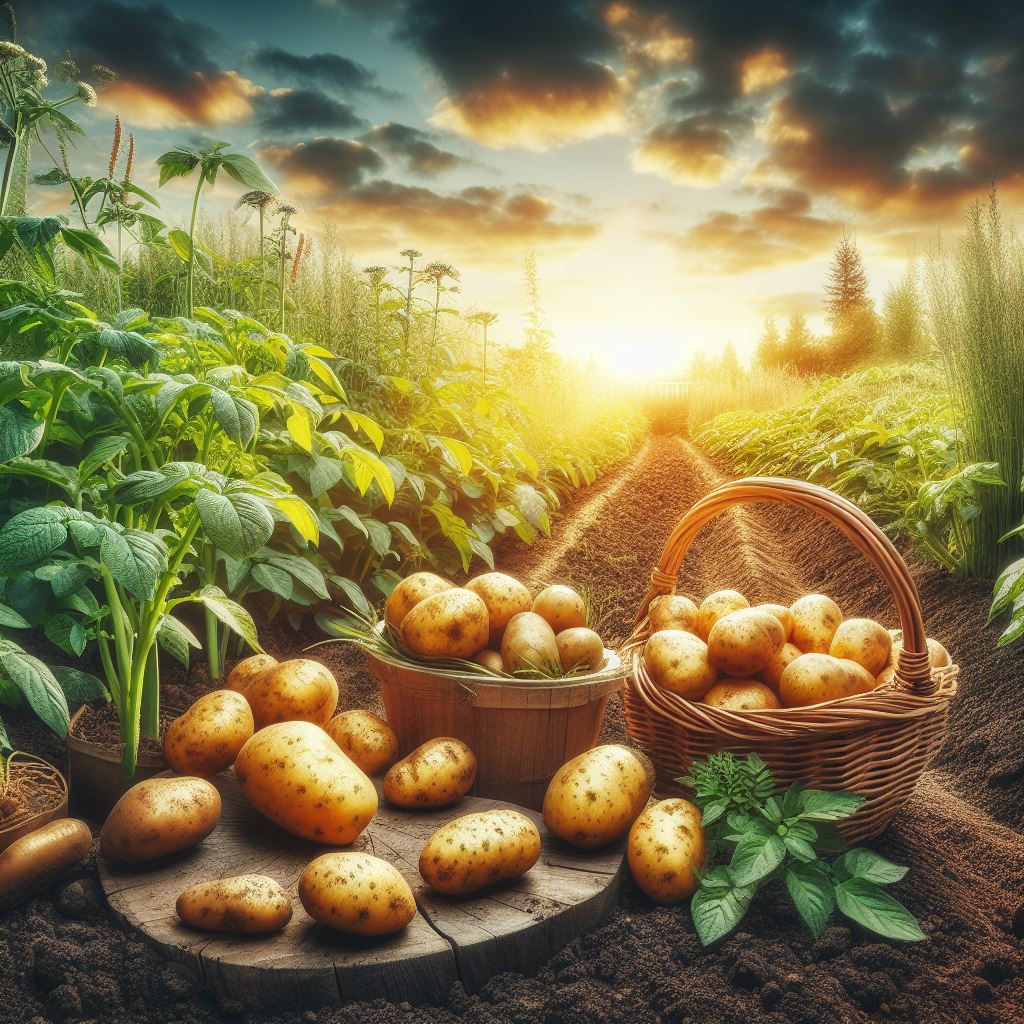Table of Contents
- 1 Introduction
- 2 Selecting the Right Potato Varieties
- 3 Preparing Seed Potatoes
- 4 Soil Preparation and Quality
- 5 How To Plant Potatoes
- 6 Caring for Potato Plants
- 7 Harvesting Potatoes
- 8 Storing Potatoes
- 9 Recipes and Cooking Tips
- 10 Frequently Asked Questions (FAQs)
- 11 Benefits of Homegrown Potatoes
- 12 Conclusion
Introduction
Potatoes, those excellent, humble tubers that grace the plates of many households worldwide, can be more than just a supermarket staple. What if we told you you could grow your potatoes from other potatoes? It’s not just a possibility; it’s an adventure waiting for every gardening enthusiast. This comprehensive guide will walk you through the fascinating journey of growing potatoes from potatoes, from choosing the perfect varieties to harvesting and savoring your homegrown spuds. Prepare to embark on a potato-growing adventure that fills your plate with the freshest, most organic potatoes and warms your gardening heart.
Selecting the Right Potato Varieties
Growing potatoes from potatoes begins with a delicious dilemma – which potato variety to choose? You’ve got a palette of choices: russet, red, yellow, fingerling, and more. Each type brings its unique flavor and charm to your garden and kitchen. Pick varieties that suit your local climate and culinary dreams to ensure your potato venture thrives. If you’re unsure where to start, consider seeking the wisdom of your local nursery or agricultural extension office to find the spuds that’ll love your garden as much as you do.
Preparing Seed Potatoes
Now, let’s talk about the stars of the show—seed potatoes. These aren’t your everyday spuds; they’re like the Olympic athletes of the potato world. They’re certified disease-free and meticulously cultivated for the sole purpose of becoming your next potato patch. To get your seed potatoes ready for the spotlight:
- Purchase Certified Seed Potatoes: These little guys come from reputable sources, ensuring they’re disease-free and ready for action.
- Chitting: Think of this as the potato spa day. Place your seed potatoes in a cool, dry, well-ventilated area for a few weeks before planting. It’s like giving them a pep talk to sprout their hearts out.
- Cutting Seed Potatoes: If you’re dealing with hefty seed potatoes, consider giving them a haircut. Cut them into smaller pieces, ensuring each has at least one “eye” (a small bud). It’s like planning a family reunion for your future potato family.
Soil Preparation and Quality
Before you invite your seed potatoes to their new home, you need to roll out the red carpet, or in this case, the perfect soil. Potatoes thrive in well-draining soil with a touch of fertility. Here’s how you can prepare for the ideal stage:
- Loosen the Soil: Grab your trusty garden fork or tiller and give the soil a spa day. Loosen it up to a depth of about 12 inches, making it the comfiest bed your potatoes could ask for.
- Enhance Drainage: If your soil is a bit of a wet blanket, throw in some organic matter, like compost, to make it more party-friendly.
- pH Level: Potatoes have their pH preferences. They like their soil slightly acidic, around a pH of 5.8 to 6.5. It’s like creating the ideal potato comfort zone. Test your soil and make it potato-perfect.
How To Plant Potatoes

How to plant potatoes
Planting potatoes is like arranging the seating at a grand feast. You want everyone to have a good time. Here’s your seating plan:
- Timing: Think of it as sending out your potato invitations. Plant your potatoes in early spring, around two to three weeks before your area’s last expected frost date.
- Spacing: It’s like giving each guest the perfect amount of elbow room. Dig trenches about 3 inches deep and 12-15 inches apart. Place your sprouted seed potatoes face up, and give them about 10-12 inches of space within the rows.
- Hilling: As your potato party gets going, gradually build up the soil around them. It’s like tucking them in with blankets to protect the tubers from the spotlight. Continue hilling until the soil mounds about 4-6 inches above the ground.
Caring for Potato Plants
Your potato guests need pampering, and it starts with proper care:
- Watering: Imagine your potatoes are enjoying a spa day by the pool. Keep the soil consistently moist but not soggy. Think of it as serving them the perfect poolside cocktail.
- Fertilizing: It’s like preparing a gourmet meal for your guests. Use a balanced fertilizer or nourishing compost to give your potatoes the royal treatment. But remember, don’t go overboard with nitrogen; too much could lead to overly leafy plants and fewer tubers.
- Pest and Disease Management: Watch for gatecrashers like Colorado potato beetles and aphids. Think of it as being the bouncer at your potato party. Use organic pest control methods whenever possible and invite disease-resistant potato varieties to keep the party going without any hitches.
Harvesting Potatoes
The moment you’ve been waiting for is here—potato harvest time! It’s like the grand finale of a spectacular show. Here’s how to make it a showstopper:
- Harvesting Time: When the potato plant tops start to wither, usually in late summer or early autumn, it’s like the closing act of a thrilling performance. That’s your cue to start the harvest.
- Harvesting Technique: Imagine you’re an archaeologist unearthing hidden treasures. Gently use a garden fork to lift the potatoes from the soil, ensuring no harm to the precious tubers.
- Curing: After the grand reveal, let your potatoes have a little post-show downtime. Please place them in a cool, dark, and well-ventilated area for a few days. It’s like giving them a spa day to develop a thicker skin for extended storage.
Storing Potatoes
To ensure your potato stars remain fresh through their winter vacation, follow these steps:
- Curing: The potatoes you’ve just unveiled need a breather. Let them cure for about two weeks in an area with temperatures around 45-60°F (7-15°C) and high humidity.
- Storage Location: Find a cozy, dark, calm, and well-ventilated spot to keep your potatoes happy. Think of it as sending them on a potato holiday so they return with all their flavors intact.
- Storage Containers: Choose containers that let your potatoes breathe, like burlap sacks or bags with tiny holes. Avoid locking them in airtight containers; potatoes need to chat and breathe.
Recipes and Cooking Tips
Now that your garden has rewarded you with a bountiful potato harvest, it’s time to celebrate with a culinary extravaganza. Here are some delightful potato recipes to make your taste buds dance:
- Roasted Garlic Mashed Potatoes: Picture creamy mashed potatoes with a dash of roasted garlic—ideal for special gatherings.
- Crispy Potato Wedges: These seasoned potato wedges are the life of the snack or side dish party.
- Potato and Leek Soup: Warm, hearty, and easy to make, it’s like a cozy hug in a bowl.
- Potato Salad: The classic crowd-pleaser, perfect for picnics and barbecues.
Frequently Asked Questions (FAQs)
Let’s tackle a few questions about growing potatoes from potatoes.
- Can I plant store-bought potatoes? While it’s theoretically possible, it’s not the best idea. Store-bought potatoes can carry diseases that may crash your garden party.
- How long does it take to grow potatoes from potatoes? Think of it as a seasonal journey. Potatoes usually need 90 to 120 days from planting to harvest, like the entire course of a blockbuster movie.
- What is the best time to plant potatoes? Early spring, about 2-3 weeks before the last frost, is like the red carpet arrival time for your potato stars.
- Can I use organic methods for pest control? Absolutely! Organic methods like neem oil, diatomaceous earth, and companion planting are like the VIP bodyguards for your potato celebrities.
- Are potato flowers edible? While you can nibble on potato flowers, they’re not the show’s stars. The real treat is the tubers that lie beneath the soil.
Benefits of Homegrown Potatoes
The perks of growing your potatoes are like a bouquet of blooming flowers in your garden:
- Quality Control: You’re the boss in your garden. You get to grow organic, chemical-free potatoes and be the master of your soil.
- Cost Savings: Homegrown potatoes are budget-friendly, unlike their store-bought counterparts with a price tag.
- Freshness: Harvesting and eating potatoes from your garden is like savoring the juiciest fruit from the tree.
- Sustainability: Reducing the carbon footprint associated with commercial potato production is like a small step for a gardener, one giant leap for sustainability.
Conclusion
Growing potatoes from potatoes is more than just a culinary adventure; it’s a journey that brings the taste of freshly harvested spuds to your plate. You’ll soon enjoy the fruits of your gardening labor by meticulously selecting varieties, preparing your seed potatoes, and offering consistent care. Every meal featuring your homegrown, organic potatoes is a tribute to your green thumb.
Stay connected for more gardening inspiration, and here’s to your potato-growing success!

